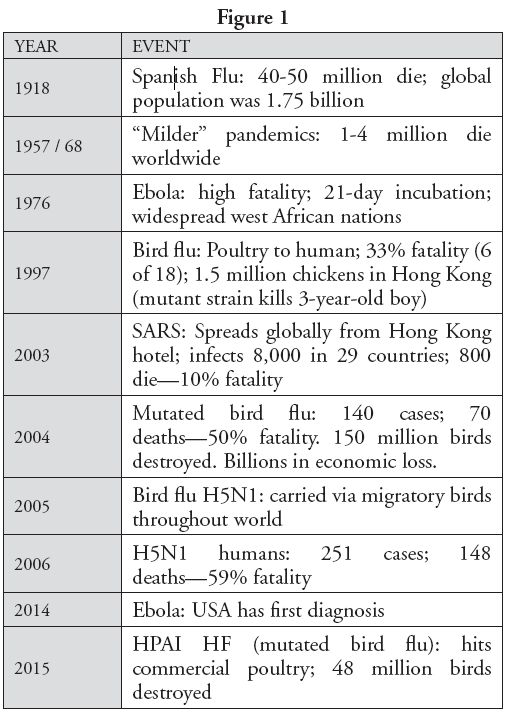On December 31, 2019, China reported an outbreak of a new coronavirus called SARS-CoV-2 (Severe Acute Respiratory Syndrome Coronavirus-2) that was detected in Wuhan City, Hubei Province, China. This new coronavirus was deemed responsible for the disease in humans now called COVID-19 (i.e., Coronavirus Disease 2019). In a matter of weeks, COVID-19 brought the world to a standstill, prompting the World Health Organization (WHO) to declare a global pandemic on March 11, 2020. At the time COVID-19 was declared a pandemic, there were a reported 113,584 cases globally—604 in the United States—and a total of 4,291 deaths. As of December 15, 2020, over 73 million people had been infected with the virus in at least 191 countries and over 1.6 million people had died from the virus.1 COVID-19 has dealt a similarly lethal blow to the global economy amounting to trillions of dollars in losses, and resulting in quarantines, curfews, closed or limited access to business, unprecedented unemployment, stock market volatility, travel restrictions, public gathering limitations or prohibitions, and the suspension or interruption of day-to-day life for practically every individual, business, and industry in the world. Indeed, some economic leaders predict a worldwide recession or depression.2
The repercussions of COVID-19 on the insurance industry are significant, and the financial and liability exposures arising from a global crisis of this magnitude prompt an analysis of a myriad of complex insurance risks under a variety of products, extending coverage for first-party property and business interruption benefits, event cancellations, and liability claims. This article explores the emergence of COVID-19, its influence on the health and economies of the world, and the resulting effect on insurance risks.
Coronaviruses
Coronaviruses are not new to either the animal or human populations. There are hundreds of coronaviruses, and they are common in many different species of animals, including camels, cattle, cats, and bats. Animal coronaviruses rarely infect people or spread between people. However, coronaviruses are zoonotic, meaning they can be transmitted between animals and people, which is called a spillover event.
What Is Coronavirus or COVID-19?
COVID-19 is believed to have originated with bats, which transmitted it to another host animal—suspected to be a pangolin—in a Wuhan, China market where live animals were sold. In turn, the host animal is believed to have transmitted the disease to one or more humans. Ultimately, COVID-19 transmitted from human to human in exponential fashion, resulting in the global crisis humanity now faces.
In humans, there are seven known types of coronaviruses. The name "corona," i.e., crown, is a reflection of the halo of spiked proteins visible in a coronavirus similar to the spikes in a crown. Four of the human coronavirus infections regularly circulate, causing mild to moderate upper respiratory tract infections often associated with common colds.
Three coronaviruses, however, have jumped from animal hosts to humans and have led to more severe diseases such as acute respiratory infections, pneumonia, respiratory distress, organ failure, and even death. Two of these are MERS (Middle East Respiratory Syndrome), which emerged in 2012 and remains in circulation in camels, and SARS (Severe Acute Respiratory Syndrome), which emerged in late 2002/ early 2003 and disappeared by 2004. Detailed investigations found that SARS was transmitted from civet cats to humans and MERS from dromedary camels to humans. The third is the virus responsible for our current global crisis, SARSCoV- 2, also known as COVID-19. Notably, COVID-19 is a mutation of the original SARS. COVID-19 had not been identified in humans prior to late December 2019.
Public Health Threat
The public health threat posed by COVID-19 is reflected in its exponential spread. The WHO declared COVID-19 a pandemic on March 11, 2020. By March 20, 2020, COVID-19 had infected more than 330,000 people and killed some 14,500 since first being reported on December 31, 2019. By December 15, 2020, global infections exceeded 73 million and global deaths exceeded 1.6 million. Nor does COVID-19 discriminate among nations. This conclusion is reflected by the fact that the United States—with one of the best health-care systems in the world—has been the epicenter the disease for months and currently reports over 16.6 million people infected and 302,689 dead.3
COVID-19's Economic Implications
Notwithstanding that social distancing can significantly slow the spread of COVID-19,4 it brings with it a significant economic toll. Investors worldwide have been spooked by the rapid spread of COVID-19, with stock markets around the globe sharply lowering in its wake.5 COVID-19 does not discriminate and has affected the largest and smallest of businesses. As these effects escalate, so, too, will insurance claims.6
Since the WHO's announcement of a pandemic, neither the effort to thwart COVID-19, or its economic fallout, has been limited to countries with weaker health care systems. It is not an exaggeration to say that the financial effect of COVID-19 has affected, and will continue to affect, the world more than any event since the Great Depression. In the United States, cities and states have issued lockdown, shelter-in-place, or stay-at-home orders (or variations thereof ), and the United States government has provided and considered stimulus packages in the trillions of dollars. Other countries have similarly sought to provide aid to their citizens and businesses at levels never seen before.
The Specter and Realization of Pandemics
By definition, a pandemic is a global disease outbreak that occurs when a new virus emerges for which people have little or no immunity and for which there is no vaccine. A flu pandemic occurs when a new influenza virus emerges that can infect people easily and spread from person to person in an efficient and sustained way.7 As previously referenced, prior major pandemics include (1) the Spanish Flu in 1918, (2) SARS in 2003, (3) the bird flu in 2006, and (4) Ebola in 2014.
COVID-19 is the latest in a list of illnesses to hit the world over the past two decades, burdening humanity with the threat of a global contagion accompanied by disease and death and presenting worldwide economies with the specter of a global supply chain shut down and social distancing policies that preclude or limit workforce operations.8
Indeed, like predecessor viruses such as Ebola, SARS, and the avian flu, coronavirus reads like a Hollywood disaster movie: a mutated variant of SARS; no available vaccination; tens of millions of people worldwide quarantined, giving a ghost-town feel to some of the most populous centers in the world; over 73 million people infected in at least 191 countries; over 1.6 million people dead; global businesses shut down or operating under significant restrictions; and health experts projecting this outbreak could linger for years, notwithstanding that in December 2020, vaccinations were approved and distribution initiated.
Historically, pandemics have warranted the attention now being given to the coronavirus. Although far from exhaustive, the events listed in Figure 1 highlight how actual or threatened pandemics have confronted humanity for the past 100 years:

To see the full article click here
Footnotes
1 Johns Hopkins University's Coronavirus Resource Center, coronavirus.jhu.edu (last visited on December 15, 2020).
2 See, e.g., The Worst Global Recession Since World War II: Deutsch Bank Just Unveiled a Bleak New Forecast as the Coronavirus Rocks Economies Worldwide, Markets Insider, March 19, 2020.
3 Coronavirus.jhu.edu (last visited on December 15, 2020).
4 See Mounk, Yascha, Cancel Everything, The Atlantic (March 10, 2020).
5 See, e.g., Global Stock Markets Roiled as China's Coronavirus Spreads, CNBC, https://www.cnbc.com (last visited on February 18, 2020).
6 Insurers Braced for Claims Following Coronavirus Lockdown, Law360 (February 3, 2020).
7 Pandemic Influenza, Centers for Disease Control and Prevention, https://www.cdc.gov (last visited on February 18, 2020).
8 See also White, Sheridan, & Carmel, The Impact of a Global Avian Flu Pandemic on the Insurance Industry, For The Defense (May 2007); White & Rowe, Insurance Coverage and Pandemic Events: What Have We Learned from the Recent Ebola Outbreak?, For The Defense (May 2015).
The content of this article is intended to provide a general guide to the subject matter. Specialist advice should be sought about your specific circumstances.

